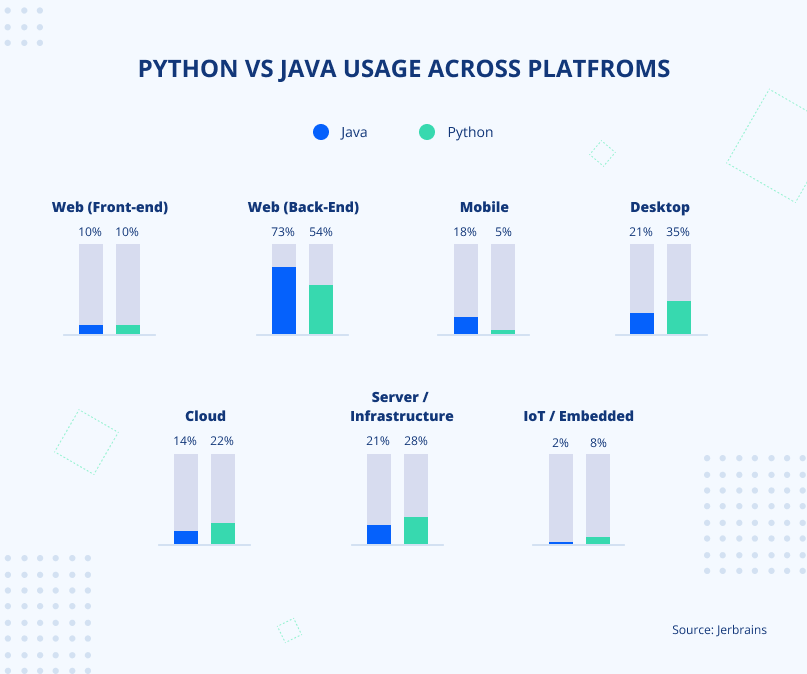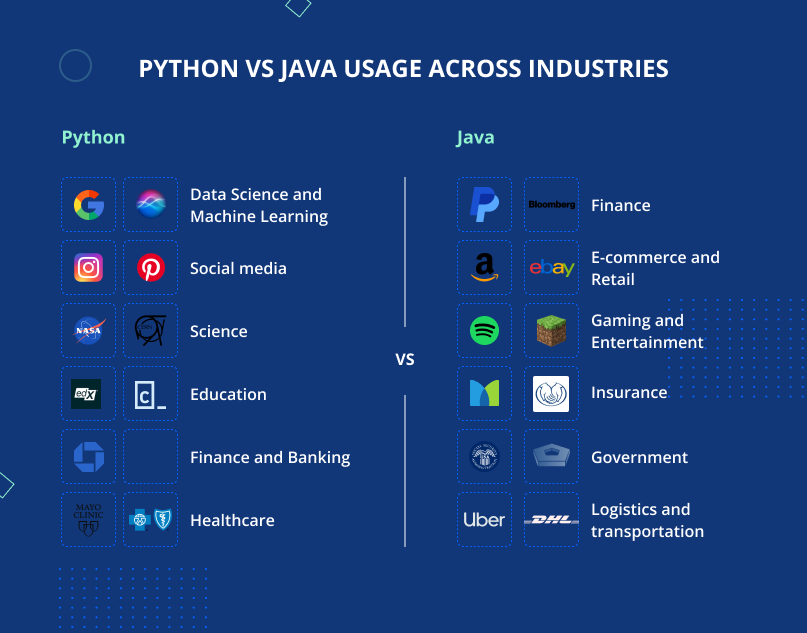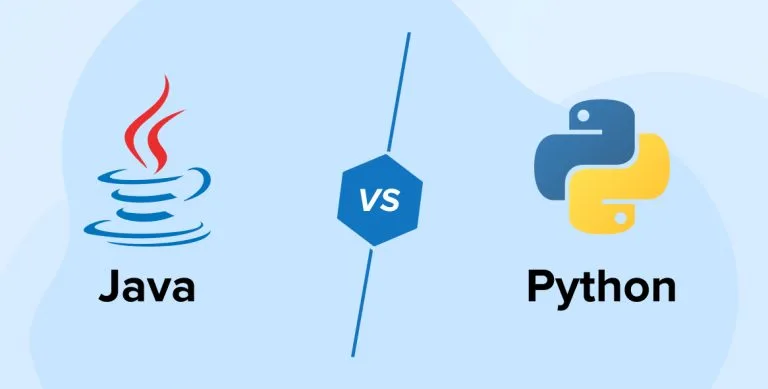Highlights
- Python is simple and readable, which makes it ideal for beginners and rapid development.
- Java offers strong performance and portability, making it suitable for large-scale, enterprise-level applications.
- With its extensive libraries, Python excels in data science and AI, while Java is preferred for mobile and web applications.
- Java’s static typing and compilation lead to faster execution and fewer runtime errors than Python’s dynamic typing.
- Python’s clear syntax speeds up coding, while Java’s complex syntax can slow development.
Java and Python are two of the most popular programming languages. Both languages are well-established, work on multiple platforms, and have large, helpful communities. However, their similarities mostly end there. When choosing between Python and Java, it’s important to understand that each language is best suited for different tasks, with its strengths and weaknesses.
In this article, we’ll compare Java vs Python, what they are, how they’re used, and the pros and cons of each.
What is Python?
Python is a programming language that’s easy to read and flexible. It’s popular among developers because of its clear syntax and ability to be used for many tasks. Python bridges the gap between low-level and high-level languages, making it a top application choice.
Key Features and Uses of Python
- Simplicity and Readability: Python’s design focuses on clear and easy-to-read code, making it simple to write and understand.
- Versatility: It’s great for web development, data analysis, machine learning, artificial intelligence, scientific computing, and automation.
- Rich Library Ecosystem: Python has many libraries and frameworks that extend its capabilities across different fields.
- Community Support: A large, active community helps improve the language and supports other developers.
What is Java?
Java is known for its object-oriented structure, strong performance, and the “Write Once, Run Anywhere” (WORA) principle. Java was designed to be platform-independent, meaning it can work on any device with the Java Virtual Machine (JVM).
Key Features and Uses of Java
- Platform Independence: Java code can run on any device with a JVM, making it very portable.
- Performance: Java often performs better than interpreted languages as a compiled language. The Just-In-Time (JIT) compiler helps by converting bytecode into native machine code just before execution.
- Object-Oriented Language (OOL): Java’s object-oriented design helps organize code. This makes it easier to manage and reuse, especially in large projects.
- Concurrency Control: Java efficiently handles multiple tasks simultaneously. This makes it suitable for high-concurrency applications like real-time trading systems.
- Enterprise-Level Applications: Java is a go-to for developing large, scalable applications, thanks to frameworks like Spring and Hibernate.
- Backend Development: Java is strong in server-side programming with powerful Java frameworks.
- Mobile Applications: Java has been a key language for developing Android apps.
- Database Connectivity: Java’s JDBC API allows it to interact with various databases.
What Are the Differences Between Python Programming vs Java?
Java and Python are popular programming languages but have key differences. Here’s a comparison of Java and Python:
- Syntax and Coding Style
- Python: Known for its readability and simplicity. Its syntax is close to human language, making it easy to understand. Python uses indentation to show blocks of code.
- Java: Has strict rules and requires lots of punctuation. It uses semicolons and curly braces to define blocks of code, which makes its syntax more complex than Python’s.
- Coding Speed
- Python: Requires fewer lines of code and is dynamically typed, which speeds up coding.
- Java: Has a more complex syntax and is statically typed, which can slow down coding. However, Java has many libraries that can make coding easier.
- App Performance and Stability
- Java: Is both compiled and interpreted. Code is compiled before running, so errors are caught early. This often results in better performance and stability.
- Python: This is interpreted, meaning code is run directly without a compilation step. Errors show up during runtime, which can lead to crashes.
- Learning Curve
- Python: Known for being easy to learn and ideal for beginners. Its simplicity makes it a popular first language.
- Java: Java is more complex than Python but still relatively easy compared to languages like C++.
Is Java Faster than Python?
When discussing Java vs Python speed, performance can be a factor in choosing the right language for your project. Both Java and Python are powerful and widely used, but they show significant differences in speed, especially when execution time is crucial.
Performance Python vs Java
- Typing: Java uses static typing, which checks types during compile time, leading to fewer runtime errors and faster execution. Python’s dynamic typing, which checks types at runtime, can slow down the program.
- Execution: Java is a compiled language, meaning its code is converted into machine code before running, typically resulting in better performance. Python interprets and executes code line by line, often making it slower.
- Performance Optimization: Java’s Just-In-Time (JIT) compiler further boosts performance by optimizing bytecode into machine code just before execution, enhancing speed.
- Error Catching: Java catches errors at compile-time, allowing developers to address issues early. Python catches errors at runtime, which can lead to slower performance and more runtime errors.
Python Benefits Over Java

Python and Java are both powerful, but Python offers several key advantages:
- Ease of Use: Python’s simpler syntax makes it easier to learn and write, reducing the learning curve for beginners.
- Rapid Development: Python requires fewer lines of code, enabling faster development cycles.
- Versatility: Python is used across web development, automation, data science, and AI, with extensive libraries and frameworks.
- Data Science and AI: Python is the preferred language for data science and AI, thanks to libraries like NumPy, Pandas, and TensorFlow.
- Dynamic Typing: Python’s dynamic typing allows for shorter code, though it can lead to runtime errors that Java’s static typing would catch earlier.
- Community and Libraries: Python has a large community and a vast ecosystem of libraries, especially in innovative fields.
- Integration and Scripting: Python excels in scripting and automating tasks, offering quick and efficient system integration.
- Readable Code: Python’s focus on readability makes code easier to understand and maintain, ideal for large teams or legacy projects.
When to Use Java vs Python?

Java is strong, fast, and secure. It’s often used for:
- Mobile app development
- Web app development
- Big Data
- Internet of Things (IoT)
- Enterprise software
Java is the best choice when you need to build a cross-platform product that is stable and scalable.
Python is simple and flexible. It’s great for:
- Machine learning
- Scientific computing
- Image processing
- Task automation
- Multimedia
Python is essential when you need to deploy quickly and test code thoroughly. Both languages are popular for different reasons. Right now, there is a bit more demand for Java developers than Python developers.
Summary
Java vs Python comparison underscores the unique strengths each language offers. Python’s simplicity and rich library ecosystem make it ideal for rapid development, data science, and AI. On the other hand, Java’s robust performance and platform independence are better suited for large-scale enterprise applications and mobile development. By considering the requirements of your project, you can make an informed choice.
FAQ
How Different Is Java vs Python?
Java is statically typed and more verbose, while Python is dynamically typed and more concise. Java is used for large-scale applications, while Python is favored for web development and data analysis.






